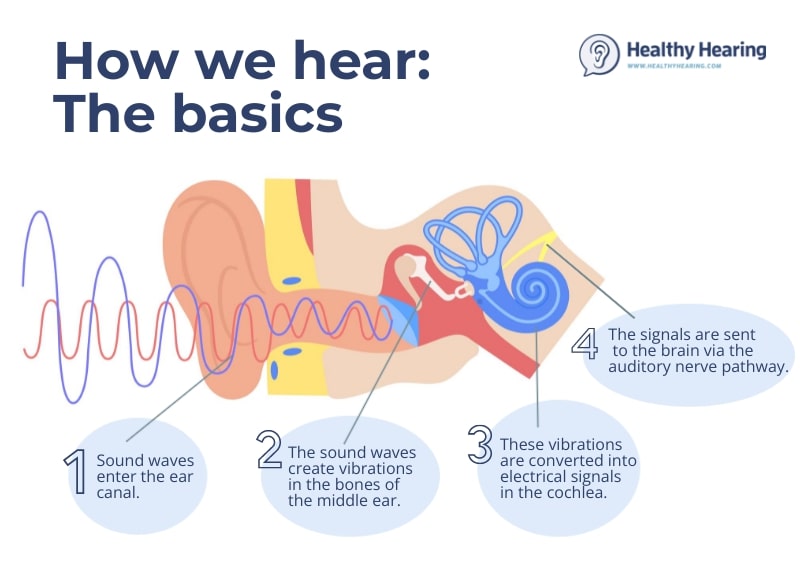|
www.HealthyHearing.com |
How we hear: A step-by-step explanation
Contributed by Madeleine Burry Key points:
Pause to think about it, and our body’s ability to translate noise into sound is incredible. But how exactly does this process unfold? We've put together a step-by-step explanation of how people hear—from the moment sound waves arrive to the outer ear, then travel through the middle and inner ear and transform into meaningful signals sent on to the brain. Our brain uses these signals to organize and communicate with the external world. How humans hear: A simplified overview
Step 1: Sound waves enter the ear.When a sound occurs, it enters the outer ear, also referred to as the pinna or auricle. The pinna is the visible portion of your ear, and its funnel-like shape is well-engineered. As sound hits the pinna, it filters and amplifies sound waves, and chutes them along into the ear canal, explains Omid Mehdizadeh, MD, an otolaryngologist at Providence Saint John’s Health Center in Santa Monica, Calif. Next, sound waves hit the eardrum, or tympanic membrane, setting it in motion. “The eardrum is a paper-thin layer of a membrane that essentially vibrates as soon as sound waves hit it—very similar to a drum,” Dr. Mehdizadeh says. Step 2: Sound moves through the middle earBehind the eardrum is the middle ear. In this part of the ear's anatomy, sound waves are amplified before they are delivered to the inner ear. Here’s how that process unfurls: The eardrum is attached to a chain of three small bones, known as the ossicles. These three bones are the smallest ones in your body. When the eardrum vibrates in response to sound waves, these bones are set into motion as well. The bone directly attached to the eardrum is the malleus (“the hammer”), which is connected at its other end to the incus (“the anvil”). The incus, in turn, is attached to the stapes (the “stirrup” or “footplate”). The shapes of the ossicles provide inspiration for their nicknames. This last bone—the stapes—is connected to the oval window, which is a membrane separating the middle ear from the inner ear. According to Scientific American, the orientation of the three bones allows them to function as a lever, amplifying the sound energy as it moves from the relatively large tympanic membrane to the relatively small oval window. Step 3: Sound moves through the inner ear (the cochlea)Vibrations from the stapes push on the oval window, and set up pressure waves in the fluid-filled cochlea, the snail-shaped inner ear that contains the organ of Corti. In the organ of Corti, vibrations are finally transformed into electrical energy by cells known as hair cells (stereocilia).
The tiny hair cells lining the cochlea are stimulated by different frequencies. For example, many people with hearing loss have high-frequency hearing loss, making it harder to hear high-pitched sounds. This means the hair cells responsible for detecting high frequencies are damaged. (While less common, some people have low-frequency hearing loss or mid-range hearing loss.) You’re born with about 16,000 of these hair cells, according to the Centers for Disease Control and Prevention (CDC). These hair cells translate the vibrations from sound waves into electrical impulses that then travel along a complex pathway of nerve fibers to the brain. Note: Hair cells play a vital role in your hearing. They’re also quite fragile: Loud sounds can damage or even destroy them, and once they’re destroyed, they can’t be repaired—and you’ll feel the effects of noise-induced hearing loss. Blasting hair cells with noise is akin to trees in a hurricane, struggling to remain standing. Step 4: Your brain interprets the signal.
via a complex circuit of auditory nerve pathways to the auditory cortex and other parts of the brain that regulate awareness and sensory perception. (Some of these pathways shut down to let you sleep at night, for example, even if noise is present). Sound processing likely occurs in both the cochlea and the brain, Dr. Mehdizadeh says. But most of the neurological processing of sound occurs in the brain, he says. Brain cells, known as sensory neurons, transmit the sound information to various areas of the brain, including the thalamus, temporal lobe, and auditory cortex, the National Institutes of Health explains. These are known as the auditory pathways. The auditory pathways process and decode sounds, turning them into something meaningful, like a question, a honking horn, or music. They also help distinguish between nearby, important sounds and less vital background sounds, as well as processing the direction and location of sounds. Many parts of hearing work directly in concert with the vestibular, or balance system, which is located nearby, within the semicircular canals of the inner ear. "There's many different centers in the brain that are interpreting and receiving sounds," Dr. Mehdizadeh says. How exactly your brain works when it comes to sound is still being explored by researchers. For example, tinnitus, or ringing in the ears, is still poorly understood, even as common as it is. Common hearing disordersGiven this elaborate, multi-step process that allows humans to hear, it’s no wonder that sometimes things go wrong along the way. Anything that obstructs the transmission of sound can lead to issues, Dr. Mehdizadeh says. Here, the types of hearing loss, and where the problem starts within the process:
How hearing aids can help—and their limitsHearing aids can be transformative for people with hearing loss. But ask any hearing expert and they’ll note that hearing aids are not like eyeglasses—that is, getting fitted for hearing aids will improve your hearing, but it won’t restore it to its original state, as slipping on eyeglasses does. “People think that ears are invincible,” Dr. Mehdizadeh says. But as you’ve seen, damage to hair cells can cause the ears to be unable to transmit sounds properly. “People need to be more aware of sound- and noise-induced hearing loss,” he says. To the extent that you can, protect your hearing, avoiding loud sounds and dealing with health-related problems that could affect your hearing in a timely manner. More: Madeleine Burry
|
Featured clinics near me
Hearing Health Solutions from Ohio ENT - Columbus
974 Bethel Rd Ste B
Columbus, OH 43214
Earzlink Hearing Care - Reynoldsburg
7668 Slate Ridge Blvd
Reynoldsburg, OH 43068

Find a clinic
We have more hearing clinic reviews than any other site!



 Madeleine Burry is a Brooklyn-based freelance writer and editor. She's written about health for several online publications, including Women's Health, Prevention, Health, Livestrong and Good Housekeeping. You can follow her on Twitter @lovelanewest.
Madeleine Burry is a Brooklyn-based freelance writer and editor. She's written about health for several online publications, including Women's Health, Prevention, Health, Livestrong and Good Housekeeping. You can follow her on Twitter @lovelanewest.